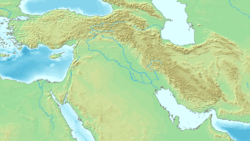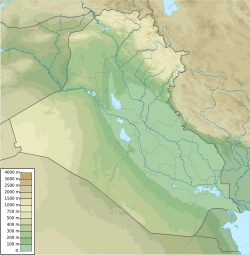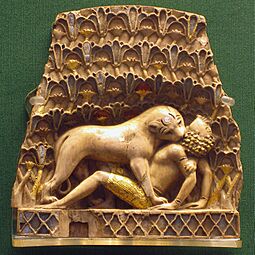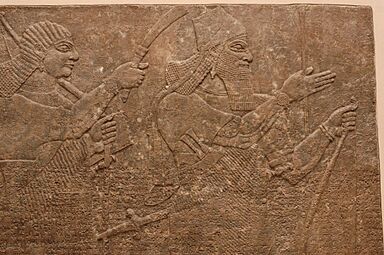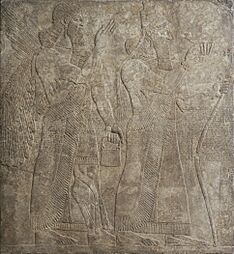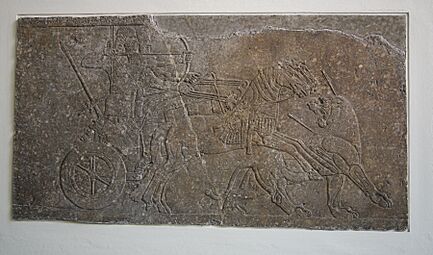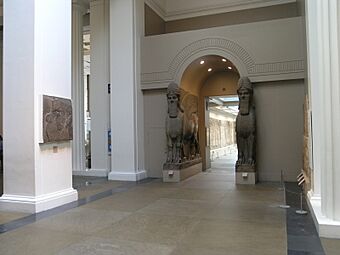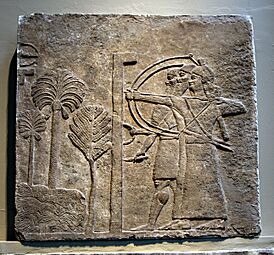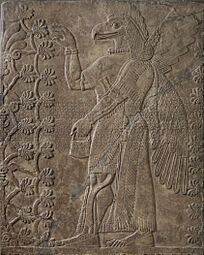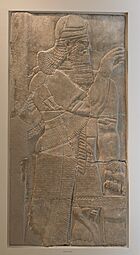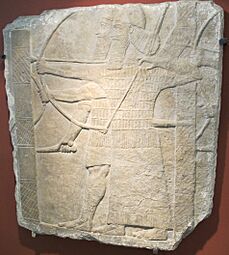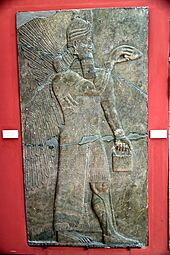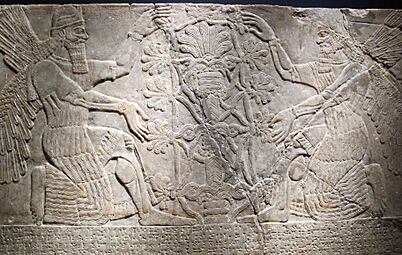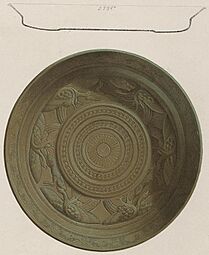Nimrud facts for kids
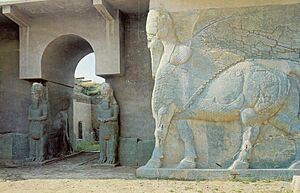
A lamassu at the North West Palace of Ashurnasirpal II before destruction in 2015.
|
|
| Alternative name | Calah, Kalakh, Kalhu |
|---|---|
| Location | Numaniyah, Al-Hamdaniya, Nineveh Governorate, Iraq |
| Region | Mesopotamia |
| Coordinates | 36°05′53″N 43°19′44″E / 36.09806°N 43.32889°E |
| Type | Settlement |
| Area | 3.6 km2 (1.4 sq mi) |
Nimrud is an ancient Assyrian city in Iraq. Its original Assyrian name was Kalḫu, and it's also known as Calah from the Bible. It's located about 20 miles (32 km) south of the city of Mosul, in a flat area called the Nineveh Plains.
Nimrud was a very important Assyrian city from around 1350 BC to 610 BC. It was built in a great spot, about 6 miles (10 km) north of where the Tigris River meets another river called the Great Zab. The city covered a huge area of about 360 hectares (890 acres). Today, the ruins of Nimrud are found near the modern village of Noomanea.
The name Nimrud was first written down by a traveler named Carsten Niebuhr in the mid-1700s. Later, in the mid-1800s, people studying the Bible thought this site was the ancient city of Calah, mentioned in the Bible's book of Genesis.
Archaeologists started digging at Nimrud in 1845. They found many amazing things, and most of these discoveries were sent to museums in Iraq and other countries. In 2013, a project called the "Nimrud Project" began. Its goal was to write the full history of the city and track all the artifacts found there. These artifacts are now spread across at least 76 museums worldwide!
Sadly, in 2015, a terrorist group called Islamic State (ISIL) announced they would destroy the site. They saw the ancient Assyrian art as "un-Islamic." In March 2015, the Iraqi government reported that ISIL had used bulldozers to destroy parts of the city. Videos released by ISIL showed this destruction happening. In November 2016, Iraqi forces took back the site. Later, visitors confirmed that about 90% of the excavated parts of the city had been completely destroyed. Iraqi forces have guarded the ruins of Nimrud ever since, and work to rebuild is now underway.
Contents
History of Nimrud
Nimrud has a long and fascinating history, from its early days as a city to becoming a powerful capital.
Early Beginnings
The Assyrian king Shalmaneser I (who ruled from 1274–1245 BC) helped Kalḫu (Nimrud) grow into a major city. This was during the time of the Middle Assyrian Empire. However, the city of Assur remained the main capital of Assyria for a long time before Nimrud.
Becoming a Grand Capital
Nimrud became truly famous when King Ashurnasirpal II (883–859 BC) of the Neo-Assyrian Empire decided to make it his new capital. He chose Nimrud over Assur. He built a huge palace and many temples in the city.
Thousands of workers helped build a 5-mile (8 km) long wall around the city. They also built a magnificent palace. Inscriptions carved into limestone told about the palace. They said it was built from special woods like cedar and cypress. The inscriptions also mentioned statues of mythical creatures, like winged lions and bulls, that guarded the palace gates. These statues were made from white limestone and alabaster.
The king's inscriptions also described the treasures stored in the palace. These included "silver, gold, lead, copper and iron" taken from lands he had conquered. He wanted Nimrud to be the most impressive city in his empire. He even created a zoo and botanical gardens with exotic animals, trees, and flowers brought back from his military trips.
In 864 BC, a huge party was held to celebrate the grand opening of the city. This event is described on a stone slab called a Stela. By 800 BC, Nimrud had grown to about 75,000 people, making it one of the largest cities in the world!
King Ashurnasirpal's son, Shalmaneser III (858–823 BC), continued his father's work. He built an even bigger palace at Nimrud, twice the size of his father's. It covered about 12 acres (5 hectares) and had over 200 rooms. He also built a huge stepped tower called the Great Ziggurat and a temple nearby.
Nimrud remained the capital for several more kings. One important king, Tiglath-Pileser III (745–727 BC), did a lot of building in the city. He also made Eastern Aramaic the main language of the empire. Some dialects of this language are still spoken by Assyrian Christians in the region today.
However, in 706 BC, King Sargon II moved the capital to a new city called Dur-Sharrukin. After his death, the capital moved again to Nineveh. Nimrud remained an important city and a royal home. But it was largely destroyed between 616 BC and 599 BC. This happened when an alliance of groups like the Babylonians and Medes attacked the Assyrian Empire.
Archaeological Discoveries
Archaeologists have found incredible things at Nimrud, giving us a glimpse into the ancient Assyrian world.
Early Excavations
The first major excavations at Nimrud were led by Austen Henry Layard. He worked there from 1845 to 1847 and again from 1849 to 1851. After Layard, other archaeologists like Hormuzd Rassam and William Loftus continued the work.
After a long break, a British team led by Max Mallowan started digging at Nimrud again in 1949. They discovered 244 ancient letters, known as the Nimrud Letters. Many other teams from Iraq and other countries have also worked at the site over the years.
In the 1970s, a Polish team carefully documented the entire site with photos and detailed drawings. This was very important because it helped reconstruct how the ancient reliefs looked, even though many pieces are now scattered around the world.
Amazing Finds
The excavations at Nimrud uncovered remarkable stone carvings called bas-reliefs, beautiful ivory carvings, and large sculptures.
One amazing find was a statue of King Ashurnasirpal II, which was in excellent condition. Archaeologists also found huge winged creatures with human heads, known as lamassu. These weighed between 10 and 30 tons each and guarded the palace entrances. Many inscriptions found at the site tell us a lot about King Ashurnasirpal II and his time.
The palaces of Ashurnasirpal II, Shalmaneser III, and Tiglath-Pileser III have all been found. Parts of the site have also been identified as temples to ancient gods like Ninurta and Enlil. A building for Nabu, the god of writing and arts, was also discovered, along with strong city walls.
In 1988, four queens' tombs were discovered at the site. These tombs contained incredible gold jewelry and precious stones. This collection, known as the "Treasure of Nimrud," survived the invasion of Iraq in 2003 because it was safely hidden in a bank vault.
Famous Artworks
Nimrud is famous for its Assyrian sculpture, especially the palace reliefs. Layard found many pairs of the huge lamassu statues. These statues have human heads, the bodies of lions or bulls, and wings. Their heads are carved in 3D, but their bodies are carved flat into the stone.
In 1847, Layard managed to move two of these massive statues, weighing 10 tons each, to London. It was a huge effort! It took 18 months and involved loading them onto a wheeled cart pulled by 300 men. They were then put on a special barge that needed 600 inflated animal skins to stay afloat. Finally, they were brought into the British Museum.
Other similar huge statues were moved to Paris and Chicago. The Metropolitan Museum of Art in New York also has a pair.
Other important finds include the Statue of Ashurnasirpal II and the Stela of Shamshi-Adad V. These are large sculptures showing the kings. The famous Black Obelisk of Shalmaneser III, discovered by Layard in 1846, is also at the British Museum. This tall monument has inscriptions and 24 carved panels that show the king's successful military campaigns.
Many beautiful reliefs (flat carvings) were taken from the palaces. These show scenes of hunting, battles, and religious ceremonies. You can see them in various museums around the world.
The Nimrud Ivories are another amazing discovery. These are small, detailed carvings made of ivory, likely used to decorate furniture. They were found in a palace storeroom and probably came from different parts of the ancient Near East. Most of these are now in the British Museum and the National Museum of Iraq.
Destruction and Reconstruction
Nimrud's ancient monuments have always faced challenges from the harsh Iraqi weather. Strong winds and heavy rains could cause damage to the old stone carvings.
In mid-2014, the Islamic State of Iraq and the Levant (ISIL) took control of the area around Nimrud. In early 2015, they announced their plan to destroy many ancient artifacts. They believed these items were against their religion. On March 5, 2015, Iraq reported that ISIL militants had used bulldozers to destroy parts of Nimrud.
ISIL filmed the destruction, saying they were destroying "idols and statues" that people used to worship. They also destroyed other ancient sites.
Irina Bokova, the head of UNESCO, said that destroying cultural heritage on purpose is a "war crime."
In November 2016, Iraqi forces successfully recaptured the city from ISIL. However, by then, about 90% of the excavated part of Nimrud had been completely destroyed. The Great Ziggurat was flattened, and only broken walls remained of Ashurnasirpal II's palace. The famous lamassu statues that guarded the gates were smashed into pieces.
Rebuilding the Site
A project to restore Nimrud began in July 2017 with help from UNESCO. The first step was to study the damage and train Iraqi teams to help with preservation.
In October 2019, the second phase started, focusing on restoring the northern palace. As of 2020, archaeologists from the Nimrud Rescue Project have been working at the site. They are training local Iraqi archaeologists to protect their heritage and preserve what remains. There are plans for reconstruction and tourism, but these will take time. In late 2022, a team from the University of Pennsylvania found a new door slab with inscriptions during their excavations.
Security After ISIL
After Nimrud was freed from ISIL, an Assyrian security group called the Nineveh Plain Protection Units took over guarding the ancient city.
Gallery
- Items excavated from Nimrud, located in museums around the world
-
Nimrud ivory plaque, with original gold leaf and paint, showing a lion killing a human (British Museum)
-
Assyrian lion hunt (Pergamon)
-
Lamassu, Stelas, Statue, Relief Panels, including the Black Obelisk of Shalmaneser III (British Museum)
-
Lamassu of Tiglath-pileser III (British Museum)
-
City under siege (British Museum)
-
Cavalry battle (British Museum)
-
Eagle-headed deity (Los Angeles County Museum of Art)
-
Lamassu (Metropolitan Museum)
-
Relief with Winged Genius (Walters Art Museum)
-
Two Nimrud ivories made in Egypt (British Museum)
-
Stela of Shamshi-Adad V, Height 195.2 cm, Width 92.5 cm, (British Museum)
-
Two archers (Hermitage Museum)
See also
- Cities of the ancient Near East
- Hatra
- Islamic Iconoclasm
- Nimrud lens
- Short chronology timeline


